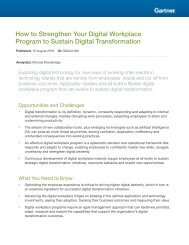The_Future_of_Employment
Create successful ePaper yourself
Turn your PDF publications into a flip-book with our unique Google optimized e-Paper software.
do not account for future wage levels, capital prices or labour shortages. While<br />
these factors will impact on the timeline <strong>of</strong> our predictions, labour is the scarce<br />
factor, implying that in the long-run wage levels will increase relative to capital<br />
prices, making computerisation increasingly pr<strong>of</strong>itable (see, for example,<br />
Acemoglu, 2003).<br />
Second, regulatory concerns and political activism may slow down the process<br />
<strong>of</strong> computerisation. <strong>The</strong> states <strong>of</strong> California and Nevada are, for example,<br />
currently in the process <strong>of</strong> making legislatory changes to allow for driverless<br />
cars. Similar steps will be needed in other states, and in relation to various<br />
technologies. <strong>The</strong> extent and pace <strong>of</strong> legislatory implementation can furthermore<br />
be related to the public acceptance <strong>of</strong> technological progress. 23 Although<br />
resistance to technological progress has become seemingly less common since<br />
the Industrial Revolution, there are recent examples <strong>of</strong> resistance to technological<br />
change. 24<br />
We avoid making predictions about the legislatory process and<br />
the public acceptance <strong>of</strong> technological progress, and thus the pace <strong>of</strong> computerisation.<br />
Third, making predictions about technological progress is notoriously difficult<br />
(Armstrong and Sotala, 2012). 25 For this reason, we focus on near-term<br />
technological breakthroughs in ML and MR, and avoid making any predictions<br />
about the number <strong>of</strong> years it may take to overcome various engineering bottlenecks<br />
to computerisation. Finally, we emphasise that since our probability<br />
estimates describe the likelihood <strong>of</strong> an occupation being fully automated, we<br />
do not capture any within-occupation variation resulting from the computerisation<br />
<strong>of</strong> tasks that simply free-up time for human labour to perform other tasks.<br />
reveals a causal relationship between the access to cheap labour and mechanisation in agricultural<br />
production, in terms <strong>of</strong> sustained economic transition towards increased mechanisation in<br />
areas characterised by low-wage worker out-migration (Hornbeck and Naidu, 2013).<br />
23 For instance, William Huskisson, former cabinet minister and Member <strong>of</strong> Parliament for<br />
Liverpool, was killed by a steam locomotive during the opening <strong>of</strong> the Liverpool and Manchester<br />
Railway. Nonetheless, this well-publicised incident did anything but dissuade the public<br />
from railway transportation technology. By contrast, airship technology is widely recognised as<br />
having been popularly abandoned as a consequence <strong>of</strong> the reporting <strong>of</strong> the Hindenburg disaster.<br />
24 Uber, a start-up company connecting passengers with drivers <strong>of</strong> luxury vehicles, has recently<br />
faced pressure from from local regulators, arising from tensions with taxicab services.<br />
Furthermore, in 2011 the UK Government scrapped a 12.7 billion GBP project to introduce<br />
electronic patient records after resistance from doctors.<br />
25 Marvin Minsky famously claimed in 1970 that “in from three to eight years we will have<br />
a machine with the general intelligence <strong>of</strong> an average human being”. This prediction is yet to<br />
materialise.<br />
43





